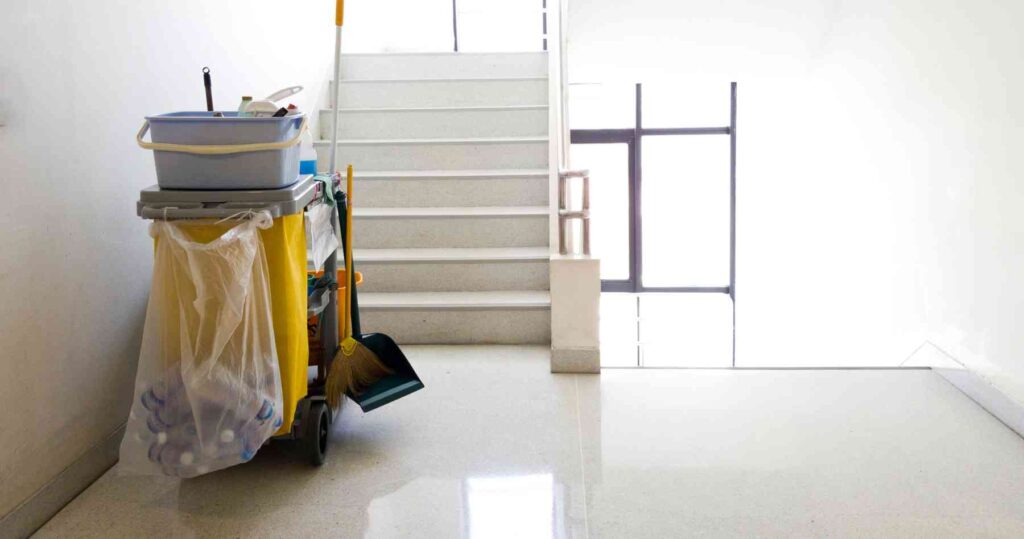The Importance of Regular Deep Cleaning for Commercial Buildings
As the COVID-19 pandemic continues to affect the world, the importance of maintaining a clean and safe environment in commercial buildings has never been more critical. Regular deep cleaning is crucial to keep employees and customers safe, maintain the overall appearance and integrity of the building, and prevent the spread of germs and viruses. Regular deep cleaning goes beyond the regular cleaning and maintenance, it involves a thorough cleaning of the entire building and ensures that all surfaces are free from dirt, grime, and bacteria. In this article, we will discuss the importance of regular deep cleaning for commercial buildings, including the benefits, the areas that need special attention, and the steps involved in a deep cleaning process.

Benefits of Regular Deep Cleaning
Improved Air Quality
One of the main benefits of regular deep cleaning is improved air quality. Dust, dirt, and other particles that accumulate in commercial buildings can cause respiratory problems and aggravate allergies. Deep cleaning removes these particles and helps to improve the overall air quality, making the environment healthier for employees and customers.
Regular deep cleaning also helps to keep HVAC systems and air ducts clean, which improves the circulation of air and reduces the risk of mold and mildew growth.
Reduced Risk of Illness
Regular deep cleaning also helps to reduce the risk of illness. Germs and bacteria can easily spread in commercial buildings, particularly in areas that are frequently touched such as door handles, elevator buttons, and stair railings.
Deep cleaning these areas, as well as others, can help to prevent the spread of germs and illnesses. Additionally, regular deep cleaning can also help to eliminate any unpleasant odors that may linger in the building, reducing the risk of triggering respiratory problems or allergies.
Better Appearance
Regular deep cleaning also helps to maintain the appearance of the building. A clean and well-maintained building creates a better impression on customers and visitors, and it can also increase the overall morale of employees.
A dirty and poorly maintained building can create a negative first impression on visitors and customers, and it can also be demotivating for employees. Regular deep cleaning ensures that the building looks clean, well-maintained, and inviting.
Areas that Need Special Attention:
Restrooms
Restrooms are one of the areas that require special attention during a deep cleaning. They are used by many people, and if not cleaned properly, can become a breeding ground for germs and bacteria.
During a deep cleaning, all surfaces should be thoroughly cleaned and disinfected, including toilets, sinks, counters, and mirrors. Special attention should be given to areas such as toilet bowls, urinals, and shower stalls, which can harbor a high amount of germs and bacteria.
Kitchens and Break Rooms
Kitchens and break rooms are another area that requires special attention. These areas are often used for food preparation, and if not cleaned properly, can become a source of food contamination.
During a deep cleaning, all surfaces should be thoroughly cleaned, including countertops, appliances, and floors. Special attention should be given to areas such as ovens, microwaves, and refrigerators, which can harbor a high amount of grease and food particles.
High-Traffic Areas
High-traffic areas, such as hallways and stairwells, also need special attention during a deep cleaning. These areas are frequently used, and dirt and grime can easily accumulate.
During a deep cleaning, all surfaces should be thoroughly cleaned and disinfected, including floors, walls, and handrails. Special attention should be given to areas such as door handles, light switches, and elevator buttons, which can harbor a high amount of germs and bacteria. Additionally, in high traffic areas such as entryways, it’s important to ensure that floor mats are cleaned, and any stains or spills are removed.
This will ensure that dirt, debris and moisture is not tracked throughout the building, which can cause slips and falls, and also contribute to the deterioration of the flooring.
Get a Professional Quotation
Click here to request a professional commercial cleaning services quotation, we will visit your site, consult with you, and tailor-make a cleaning solution for you…

Steps Involved in a Deep Cleaning Process
Deep cleaning is an important part of keeping your home clean and tidy. It involves more than just regular cleaning and requires a thorough process to be followed in order to get the best results. This article will discuss the steps involved in deep cleaning, what tools are needed, and how often it should be done. With a comprehensive understanding of this process, you can ensure that your home is always kept in top condition.
Here's what some of our clients say....
ExcellentBased on 4 reviews Trustindex verifies that the original source of the review is Google.
Trustindex verifies that the original source of the review is Google. Abraham Mostert2021-12-17Thanks for cleaning my offices so efficiently, it's important for us to portray a clean and professional image to our clients and the staff is just happier in a clean officeTrustindex verifies that the original source of the review is Google.
Abraham Mostert2021-12-17Thanks for cleaning my offices so efficiently, it's important for us to portray a clean and professional image to our clients and the staff is just happier in a clean officeTrustindex verifies that the original source of the review is Google. Scaffsa Cape Town2021-08-20Thanks for deep cleaning the factory after our COVID scare, it is important for the staff to feel safe at work, happy with the fast response...Trustindex verifies that the original source of the review is Google.
Scaffsa Cape Town2021-08-20Thanks for deep cleaning the factory after our COVID scare, it is important for the staff to feel safe at work, happy with the fast response...Trustindex verifies that the original source of the review is Google. Pieter Kotze2021-05-18As an estate agent it is important to me that when I recommend a cleaning company to clients I can rely on them doing a good job and not embarrass me, thank you CIC for being such a company.Trustindex verifies that the original source of the review is Google.
Pieter Kotze2021-05-18As an estate agent it is important to me that when I recommend a cleaning company to clients I can rely on them doing a good job and not embarrass me, thank you CIC for being such a company.Trustindex verifies that the original source of the review is Google. Stu Mailer2021-03-17Keeping a lab clean is a tricky job, these guys have got it handled, the peace of mind is comforting, knowing a good cleaning and disinfecting job was done, everytime.
Stu Mailer2021-03-17Keeping a lab clean is a tricky job, these guys have got it handled, the peace of mind is comforting, knowing a good cleaning and disinfecting job was done, everytime.
Stages of a Professional Deep Cleaning
Preparation
The first step in a deep cleaning process is preparation. This includes identifying the areas that need to be cleaned, organizing the cleaning materials and equipment, and preparing the cleaning solutions. During preparation, it’s important to consider factors such as the size of the building, the number of employees and visitors, and the type of business that takes place in the building. This will determine the level of cleaning that’s needed, and the scheduling that’s required.
Dusting
The next step is dusting. This includes removing dust, dirt, and debris from all surfaces, including furniture, fixtures, and equipment. This step is important because dust can cause respiratory problems and aggravate allergies, it’s also important to dust hard-to-reach areas such as window sills and ceiling fixtures.
Cleaning
After dusting, the next step is cleaning. This includes washing all surfaces, including walls, floors, and windows. All surfaces should be cleaned with the appropriate solutions and techniques, such as using a mop for floors and a cloth for windows. It’s important to use appropriate cleaning agents that are specifically designed for the type of surface being cleaned. For example, using a harsh cleaning agent on a delicate marble floor can cause damage, and using a mild cleaning agent on a heavily soiled area may not effectively remove dirt.
Sanitizing
The final step in a deep cleaning process is sanitizing. This includes using a disinfectant to kill germs and bacteria on all surfaces, including door handles, light switches, and other frequently touched areas. This step is important because it eliminates germs and bacteria that can cause illness. Additionally, it is important to ensure that all surfaces are properly dried after sanitizing to prevent the growth of mold and mildew.
Commercial deep cleaning checklist
A deep cleaning checklist is a comprehensive list of tasks that need to be completed in order to thoroughly clean and disinfect a commercial building. It ensures that all areas of the building are cleaned and sanitized, including those that are often overlooked during regular cleaning.
This checklist is designed to help commercial building managers, custodial staff, or professional cleaning service providers ensure that the building is safe and healthy for employees and visitors. It covers all the necessary cleaning and disinfection tasks, from dusting to sanitizing, to keep the building clean, hygienic and well-maintained.
Prepare the area for cleaning by removing any clutter or debris.
Dust all surfaces, including ceiling fans, light fixtures, and window sills.
Clean all surfaces, including walls, floors, and windows.
Disinfect all surfaces, including door handles, light switches, and countertops.
Clean and disinfect restrooms, including toilets, sinks, and shower stalls.
Clean and disinfect kitchens and break rooms, including countertops, appliances, and floors.
Vacuum or sweep all carpets and flooring.
Mop all hard flooring.
Clean and disinfect high-traffic areas, such as hallways and stairwells.
Clean and maintain HVAC systems and air ducts.
Clean and maintain exterior of building, including sidewalks and entrances.
Check and refill all paper and soap dispensers.
Empty all trash receptacles and replace trash liners.
Inspect the entire building for any damages or repairs that need to be made.
Regular Deep Cleaning for Commercial Buildings: Why It Matters
Regular deep cleaning is crucial for maintaining a clean and safe environment in commercial buildings. It helps to improve air quality, reduce the risk of illness, and maintain the overall appearance of the building. However, it’s important to focus on certain areas such as restrooms, kitchens and break rooms, and high-traffic areas during the deep cleaning process.
The deep cleaning process typically involves four steps: preparation, dusting, cleaning, and sanitizing. Having a professional cleaning service to handle the deep cleaning process is beneficial, as they have the necessary equipment, expertise, and resources to perform the job efficiently. Regular deep cleaning is a proactive approach to maintaining a healthy environment and can also help to prevent expensive repairs and replacements in the long run. It’s important for commercial building managers to schedule regular deep cleaning and have it done regularly to ensure the safety, health and well-being of all individuals who come in and out of the building.
